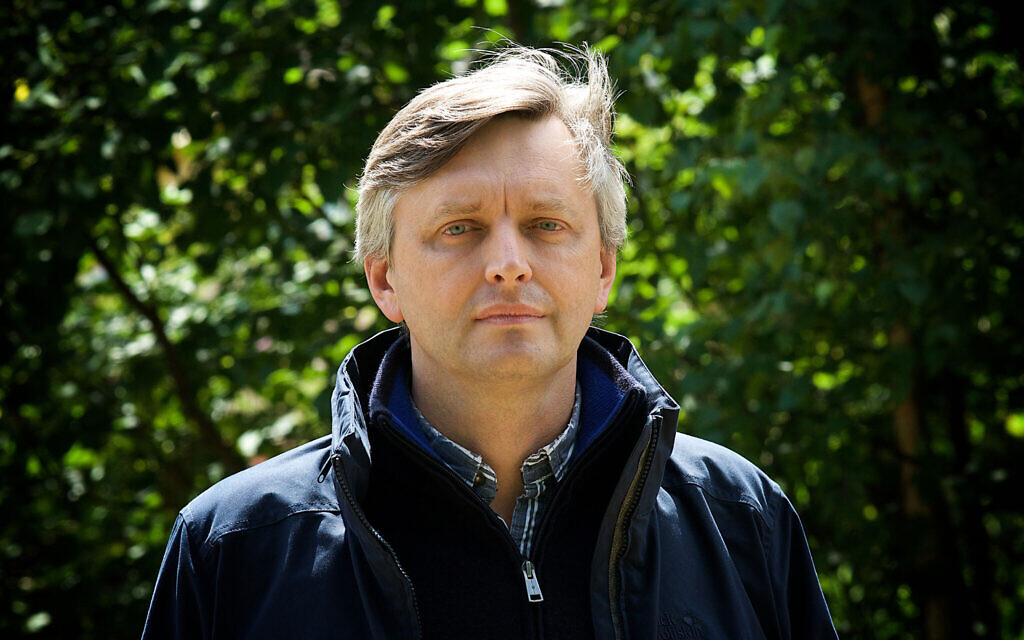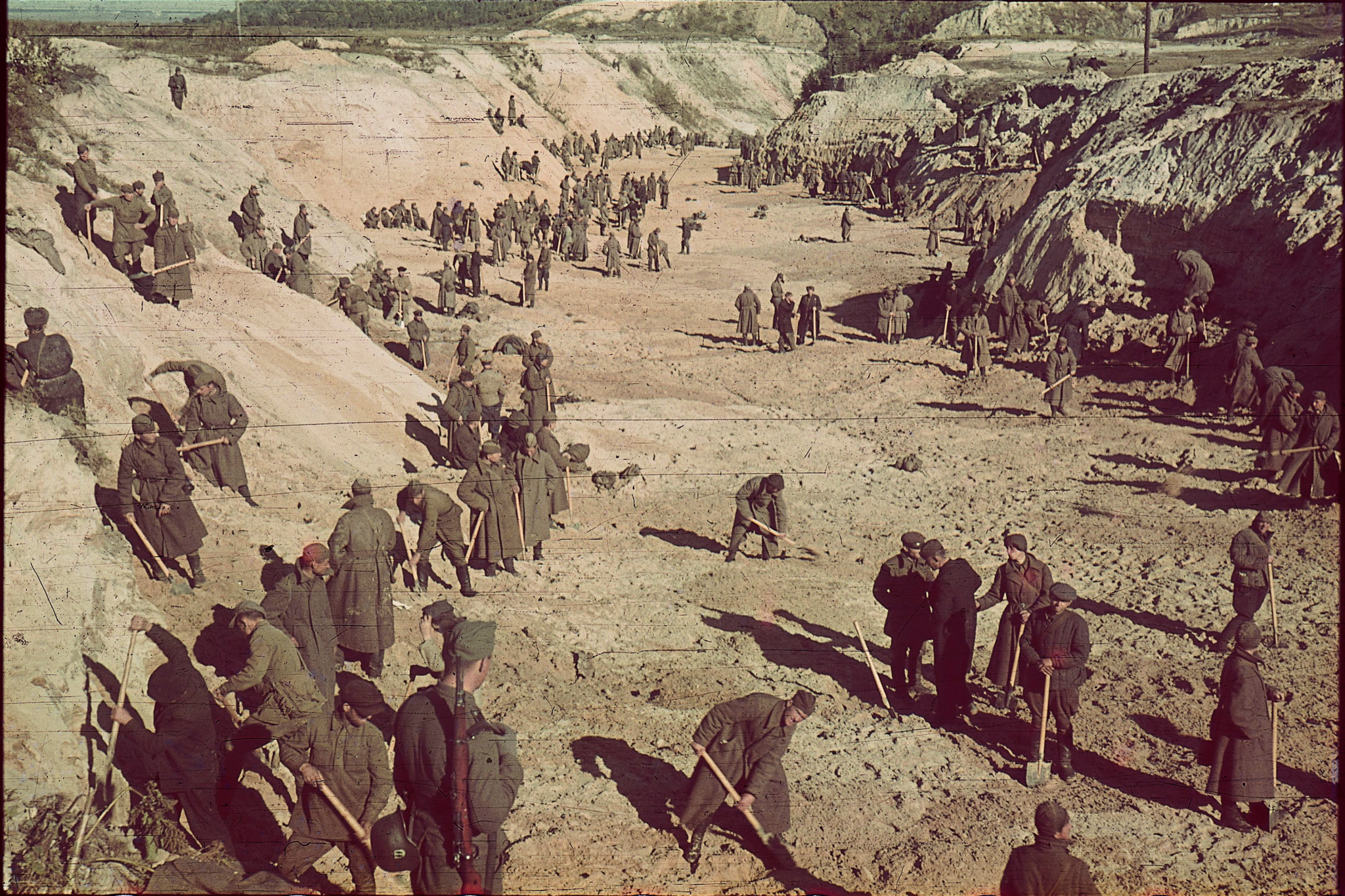Filmmaker Sergei Loznitsa grew up in ignorance close to site of Holocaust massacre. Now he’s creating 24 short films about the history — and its erasure — at the notorious ravine

Going to school in Kyiv, Ukraine, Sergei Loznitsa often wondered about what took place at Babyn Yar, or “Grandmother’s Ravine.” He was ignorant to the fact that it was where 33,771 Jews were murdered during a two-day killing spree in September 1941.
“Even though I grew up close to Babyn Yar and to the old Jewish cemetery, which was completely destroyed, and as a child I stumbled across the Jewish tombstones many times during my walks, my parents were very reluctant to answer my questions on the subject,” said Loznitsa.
Later, as a young adult, Loznitsa read the book, “Babi Yar: A Document in the Form of a Novel.” The 1966 tome helped break the silence surrounding the Holocaust in Ukraine, where German units and local collaborators murdered Jews close to their homes in open-air shootings.
“In general, people tried to avoid this subject [of the Holocaust],” Loznitsa told The Times of Israel. “There was an official formula — ‘crimes against Soviet citizens’ — that was written on the monument erected by Soviet authorities in Babyn Yar,” said the 56-year old director.
In January, the Babyn Yar Holocaust Memorial Center (BYHMC) announced plans to construct one-dozen buildings on the site of the filled-in ravine. In addition to a museum commemorating the Jews killed in 1941, another structure will memorialize 70,000 victims killed at Babyn Yar through 1945.
Since 2019, Loznitsa has partnered with BYHMC on several projects. Although the pandemic delayed production of his full-length film on Babyn Yar, the German-based Loznitsa is releasing about two-dozen short films on Babyn Yar in the months ahead.

“Even today, 80 years after the tragedy took place in Kiev, there is no consensus, there is no historical narrative, which enables the society to address, understand and preserve the memory of this tragedy,” said Loznitsa, who makes use of eye-witness testimony in several of the films.
In two of the new shorts, Soviet authorities attempt to erase memory at Babyn Yar by filling the ravine with industrial waste. A decade after that process started, the erasure triggered a mudslide that dumped “mud, water, and human-remains into the streets of Kyiv,” killing up to 1,500 people in the hushed-up March 13, 1961, “Kurenivka incident.”
Collectively, the series of films is called, “BABYN YAR. CONTEXT.” They begin with Germany’s invasion of Ukraine in 1941 and conclude with the mudslide of 1961, which Loznitsa depicts using riveting footage taken from helicopters.
Loznitsa has tackled the Holocaust in his films before, including the 2016 documentary “Austerlitz,” about tourists’ visits to former Nazi concentration camps. In 2018, he won Best Director at Cannes for the documentary “Donbass,” about Ukraine’s conflict with the Russian-supported Donetsk People’s Republic.
In an interview with The Times of Israel, Loznitsa talked about the changing face of Holocaust memory in Ukraine, including the challenge presented by what he called Russia’s “mania grandiose” in the region.
You have said that all films are “theorems” containing their own truths established by means of accepted truths. What is the truth you want readers to arrive at after watching your series of Babyn Yar short films?
My aim is to make the spectator “face” and “experience” the events and the atmosphere of the time, as if he/she was there in-person. I believe that cinema is capable of stimulating and generating this kind of insight. I would like the spectator to experience a kind of empathy, which, in its turn, may lead to an understanding of what has happened. I continue working with the archives and I keep coming across treasures which have never been seen before — sometimes, even by specialist historians, not to mention the general public.
We are currently working with the archives in Russia, Ukraine and Germany. For example, I was fortunate to discover the footage of the “Kiev Trial” of 1946, which took place in the USSR before The Nuremberg Trials were held in Germany. This was a very important trial, which dealt with, among other things, the issue of the Holocaust on the Soviet territory, and highlighted the context in which the tragedy of mass killings took place.
Today, the “Kiev Trial” seems to be completely forgotten
Today, the “Kiev Trial” seems to be completely forgotten, and very few people have even heard such an event took place just after the war.
Of the Babyn Yar films you made, which has received the most reaction?
Every episode is impressive in its own way. My aim is to preserve historical facts, to extract them from the archive shelves and to make them available for everyone to learn. For example, I managed to collect the entire footage of [survivor] Dina Pronicheva’s witness statement at the Kiev Trial. This woman returned from Hell. Every word she utters, every tone of her voice is important and precious.
What is your opinion of Russia’s role in preserving historical memory of the Holocaust and World War II?
The role of Russia, be it the Russian Empire, USSR or Russian Federation, remains unchanged. It still presents a threat to its neighbors and to all the countries it considers to be in the domain of its “strategic interests.” Recently, the country has been plunging deeper and deeper into its Soviet past.
The unlearnt lessons of history and the general feeling of resentment are very dangerous. Instead of repentance and acknowledgment of crimes committed, the Russian state displays aggression, suffers from paranoid “mania grandiose,” and wages regional conflicts whenever and wherever it can.
How do you think Ukraine has been confronting — or not confronting — its past?
In order to understand what happened, one has to know the history of Ukraine in the second half of the 19th century through the first half of the 20th century. It is important to know the history of its various regions, which in 1944 were thrown together into one Ukrainian Soviet Socialist Republic.
The unlearnt lessons of history and the general feeling of resentment are very dangerous
Perhaps, you would be surprised to hear that there were approximately 500,000 to 1,000,000 Soviet citizens or — to be more precise — former citizens of the Russian Empire, who fought for [the German] Wehrmacht, against the Red Army. A certain amount of them lived on Ukrainian territory.
It might be difficult to understand their motives today, but many of them hoped that the Germans would deliver them from Stalin, would liberate them and would support the formation of their national states: Ukrainian, Russian, Lithuanian etc.
I’m not talking about a handful of individuals; I’m talking about hundreds of thousands of people who held such views back then. I am not trying to justify their actions, but I believe that it is crucial to understand these historical processes.
Your films contain stunning use of archival film footage. Assuming you gained access to any primary film footage you wanted, is there an event in United States history you would want to make a film about?
The Manhattan Project. The decision to use nuclear weapons against Japan in 1945. The bombings of Hiroshima and Nagasaki on January 6 and 9, 1945. Since that moment, the world we live in has changed forever.
As reported by The Times of Israel
